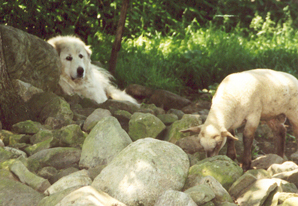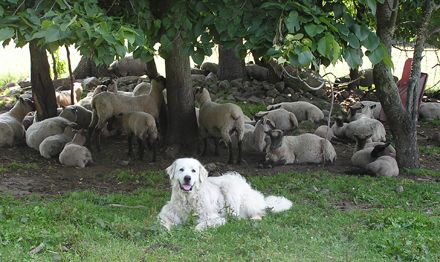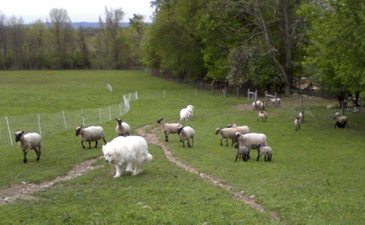Livestock Guardians
The Great Pyrenees was bred specifically as a livestock guardian 5,000 years ago. Today, these dogs have retained the guardian qualities and are the most popular of the livestock guardian breed in the NorthEast. Impressively, they are one of the few dogs that remain working at the job they were originated to do! Many studies have shown that the best protection against predators is a good livestock guardian dog!
 A livestock guardian dog, often referred to as LGD, spends the majority of time with livestock and is expected to prevent predation by coyotes or dogs and in some regions wolves or bears. Great Pyrenees will accept almost any livestock as “flock” and are common guardians for: sheep, goats, alpaca, llama, rabbits, chickens or other birds. This guardian nature is the characteristic that also makes them loyal protectors of family members and loving toward children. Great Pyrenees, whether residing as family pets or working as livestock guardians can only be placed with families who understand and take responsibility for the protective nature of the breed.
A livestock guardian dog, often referred to as LGD, spends the majority of time with livestock and is expected to prevent predation by coyotes or dogs and in some regions wolves or bears. Great Pyrenees will accept almost any livestock as “flock” and are common guardians for: sheep, goats, alpaca, llama, rabbits, chickens or other birds. This guardian nature is the characteristic that also makes them loyal protectors of family members and loving toward children. Great Pyrenees, whether residing as family pets or working as livestock guardians can only be placed with families who understand and take responsibility for the protective nature of the breed.
For some people, the image of a Pyr as livestock guardian conjures a picture of a lonely, un-kept dog, with only the company of sheep, never petted nor loved. This is the extremely rare case. In the correct setting the Pyr has full room to run and has a job he is happy to do. In addition, his people are often outside with him and provide love, warm shelter, grooming and training. This is the family farm dog who barks deeply when strangers arrive but friends come and go unmolested. And this is the discerning quality unique to Pyrs which is greatly revered by all owners.
Rescued Livestock Guardian Dogs (LGD).

The vast majority of Great Pyrenees placed by NorthEast Pyr rescue are re-homed as family pets but occasionally, people surrender well trained and proven LGD’s that become available for adoption. In many cases these dogs work as pairs, usually male and female and are surrendered as such. In this case we make every attempt NOT to split the pair. Most of these dogs are surrendered because farms have closed, the livestock are sold and the family is moving to a more urban setting.
In some cases, we have Pyrs that have not been trained or proven yet as LGD’s but we believe their qualities, while assessed in foster care, lend them toward being good LGD’s. NorthEast Pyr Resue makes every attempt to test the dogs with animals to assess their LGD potential but can not guarantee their working with livestock. In general, these dogs are young to early middle age, demonstrate NO prey/chase drive towards other animals or objects ( i.e cats, chickens and balls), exhibit a calm demeanor with no human aggression, demonstrate protective qualities ( barking and marking territory boundaries), and are physically (especially orthopedically) healthy. NorthEAst Pyr Rescue offers full disclosure regarding the background of the dog(s) at the time of the adoption so you will know their LGD experience. Unlike some organizations, NEPR does not state a Pyr is an LGD unless the dog has worked at least 1 year with livestock and has proven capability.
Requirements for a Livestock Guardian Home
 All areas must have high quality fencing in good repair, posted with LGD signage and all gates must be dog tight. This excludes, poled fencing with space between bars, barbed-wire or “invisible” electric fencing. There must be an adult normally present on the property where the dog resides. Warm and clean housing, proper nutritionally balanced food that livestock can not get to and clean water are provided daily. Proper veterinary care is offered including heart worm testing and medication. Owners who are new to LGD’s will mentor with one of NEPR’s selected volunteers experienced with livestock guardians.
All areas must have high quality fencing in good repair, posted with LGD signage and all gates must be dog tight. This excludes, poled fencing with space between bars, barbed-wire or “invisible” electric fencing. There must be an adult normally present on the property where the dog resides. Warm and clean housing, proper nutritionally balanced food that livestock can not get to and clean water are provided daily. Proper veterinary care is offered including heart worm testing and medication. Owners who are new to LGD’s will mentor with one of NEPR’s selected volunteers experienced with livestock guardians.
Adopters understand that they are taking the Pyr on a trial basis and they are responsible for the Pyr and the welfare/ safety of their animals. They agree to restrain the dog with fencing and/or leash until they are certain the Pyr will not harm their animals. They understand a Pyr that is new to LGD work will take significant time and effort to train.
Happy Tails……
Keep in mind that Pyrs love to be outside. They relish the snow and are often found playing in the mud! When LGD’s are given proper care and love they are very happy! No Pyr is happier than one that has a real job to do and…….. the livestock guardians know THEIR job is very important!
